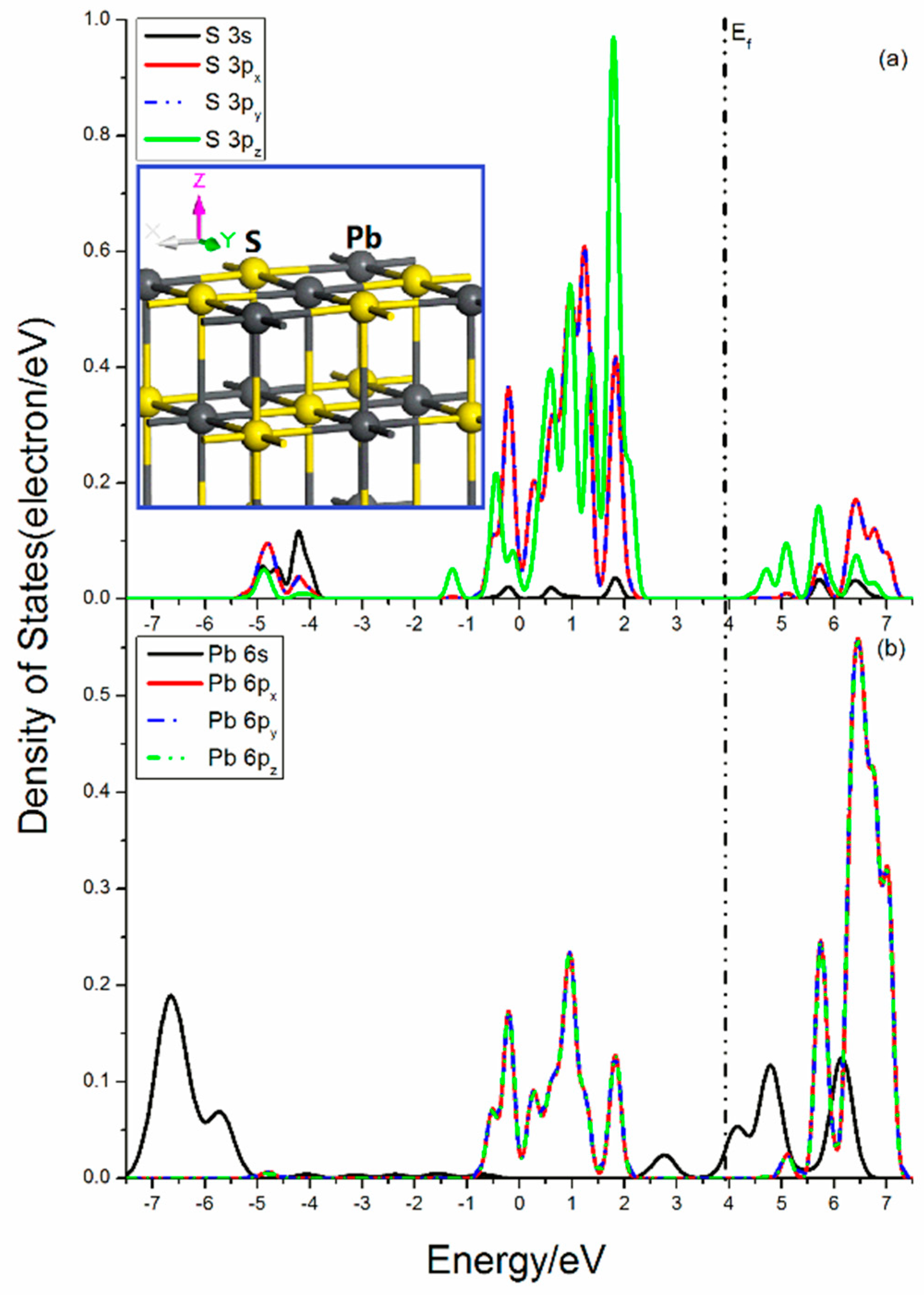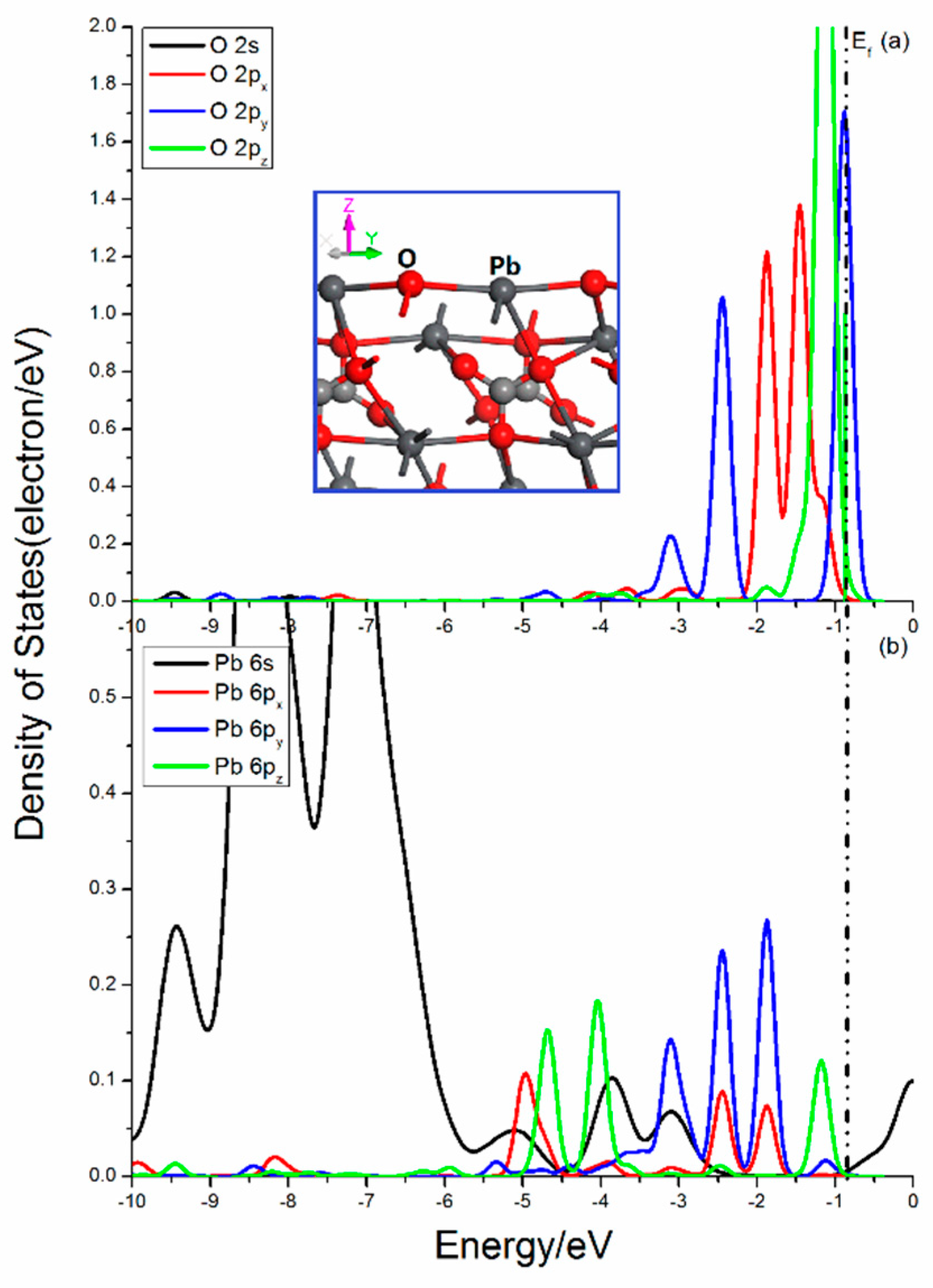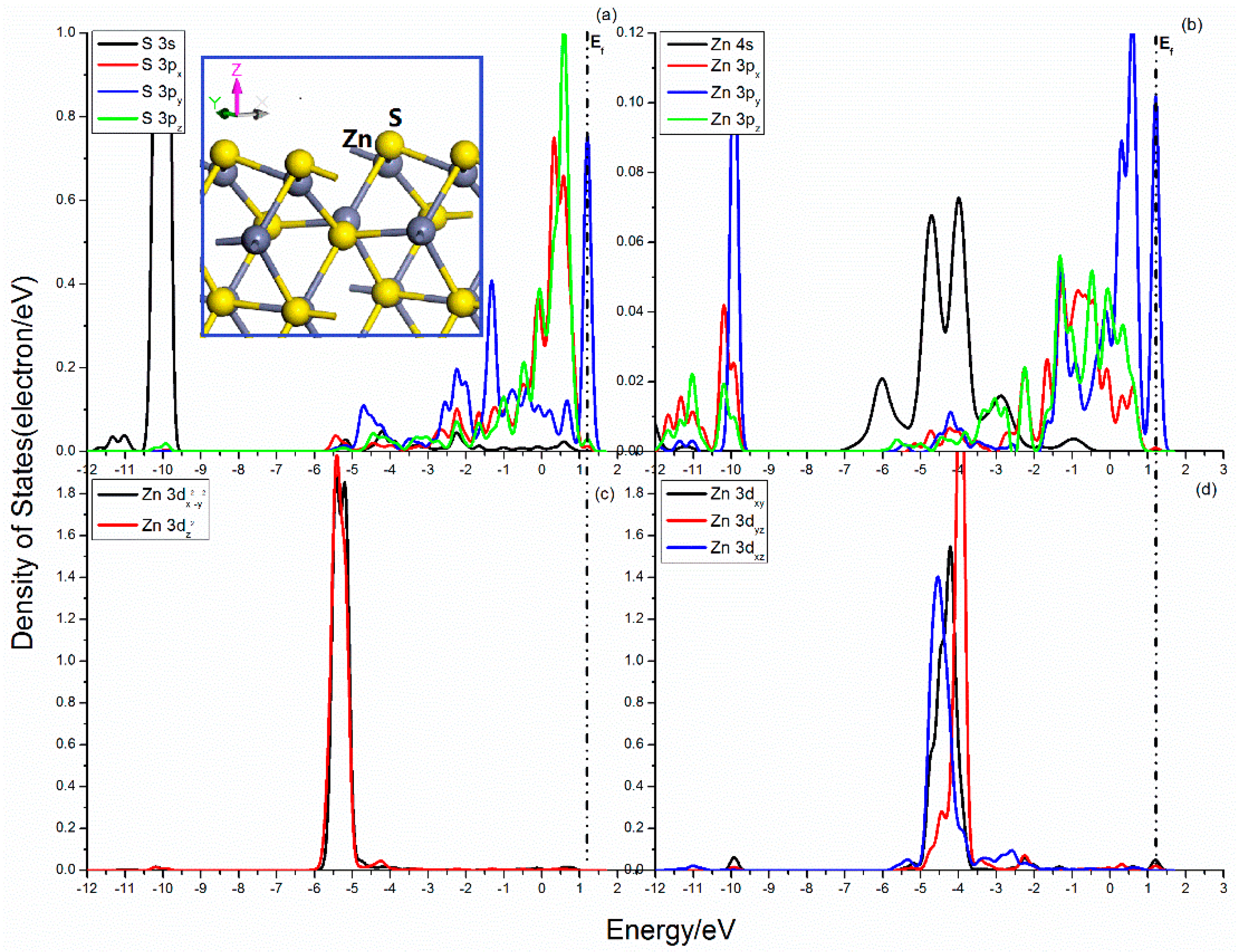Comparative Study on Surface Structure, Electronic Properties of Sulfide and Oxide Minerals: A First-Principles Perspective
Abstract
:1. Introduction
2. Computational Methods and Models
2.1. Computational Methods
2.2. Computational Models
3. Results and Discussions
3.1. Surface Relaxation
3.2. Femi Energy
3.3. Surface Electronic Structure
3.3.1. Surface Properties of Pyrite (100) and Hematite (001) Surfaces
3.3.2. Surface Properties of Galena (100) and Cerussite (110) Surfaces
3.3.3. Surface Properties of Sphalerite (110) and Smithsonite (101) Surfaces
4. Conclusions
Author Contributions
Funding
Conflicts of Interest
References
- Lakshmanan, V.I.; Roy, R.; Ramachandran, V. Innovative process development in metallurgical industry: Concept to commission; Springer: Cham, Switzerland, 2016; pp. 1–140. [Google Scholar] [CrossRef]
- Zhao, L.I.; Chen, M.; Huang, P.W.; Zhang, Q.W.; Song, S.X. Effect of grinding with sulfur on surface properties and floatability of three nonferrous metal oxides. Trans. Nonferr. Met. Soc. China 2017, 27, 2474–2480. [Google Scholar]
- Kraushofer, F.; Jakub, Z.; Bichler, M.; Hulva, J.; Drmota, P.; Weinold, M.; Schmid, M.; Setvin, M.; Diebold, U.; Blaha, P.; et al. Atomic-Scale Structure of the Hematite α-Fe2O3(1102) “R-Cut” Surface. J. Phys. Chem. C 2018, 122, 1657–1669. [Google Scholar] [CrossRef] [PubMed]
- Muscat, J.; Klauber, C. A combined ab initio and photoelectron study of galena (PbS). Surf. Sci. 2001, 491, 226–238. [Google Scholar] [CrossRef]
- Leiro, J.A.; Mattila, S.S.; Laajalehto, K.J. XPS study of the sulphur 2p spectra of pyrite. Surf. Sci. 2003, 547, 157–161. [Google Scholar] [CrossRef]
- Becker, U.; Rosso, K.M.; Hochella, M.F. The proximity effect on semiconducting mineral surfaces: A new aspect of mineral surface reactivity and surface complexation theory? Geochim. Cosmochim. Acta 2001, 65, 2641–2649. [Google Scholar] [CrossRef]
- Mcfadzean, B.; Mhlanga, S.S.; O’Connor, C.T. The effect of thiol collector mixtures on the flotation of pyrite and galena. Miner. Eng. 2013, 50, 121–129. [Google Scholar] [CrossRef]
- Zheng, X.; Pan, X.; Nie, Z.; Yang, Y.; Liu, L.; Yang, H.; Xia, J. Combined DFT and XPS Investigation of Cysteine Adsorption on the Pyrite (1 0 0) Surface. Minerals 2018, 8, 366. [Google Scholar] [CrossRef]
- Feng, Q.; Wen, S.; Deng, J.; Zhao, W. Combined DFT and XPS investigation of enhanced adsorption of sulfide species onto cerussite by surface modification with chloride. Appl. Surf. Sci. 2017, 425, 8–15. [Google Scholar] [CrossRef]
- Harmer, S.L.; Goncharova, L.V.; Kolarova, R.; Lennard, W.N.; Muñoz-Márquez, M.A.; Mitchell, I.V.; Nesbitt, H.W. Surface structure of sphalerite studied by medium energy ion scattering and XPS. Surf. Sci. 2007, 601, 352–361. [Google Scholar] [CrossRef]
- Boulton, A.; Fornasiero, D.; Ralston, J. Characterisation of sphalerite and pyrite flotation samples by XPS and ToF-SIMS. Int. J. Miner. Process. 2003, 65, 205–219. [Google Scholar] [CrossRef]
- Kiejna, A.; Pabisiak, T. Effect of substrate relaxation on adsorption energies: The example of α-Fe2O3(0001) and Fe3O4(111). Surf. Sci. 2019, 679, 225–229. [Google Scholar] [CrossRef]
- Han, C.; Li, T.; Zhang, W.; Zhang, H.; Zhao, S.; Ao, Y.; Wei, D.; Shen, Y. Density Functional Theory Study on the Surface Properties and Floatability of Hemimorphite and Smithsonite. Minerals 2018, 8, 542. [Google Scholar] [CrossRef]
- Ke, B.; Li, Y.; Chen, J.; Zhao, C.; Chen, Y. DFT study on the galvanic interaction between pyrite (100) and galena (100) surfaces. Appl. Surf. Sci. 2016, 367, 270–276. [Google Scholar] [CrossRef]
- von Oertzen, G.U.; Skinner, W.M.; Nesbitt, H.W. Ab initioand x-ray photoemission spectroscopy study of the bulk and surface electronic structure of pyrite (100) with implications for reactivity. Phys. Rev. B 2005, 72, 235427. [Google Scholar] [CrossRef]
- Long, X.; Chen, J.; Chen, Y. Adsorption of ethyl xanthate on ZnS(110) surface in the presence of water molecules: A DFT study. Appl. Surf. Sci. 2016, 370, 11–18. [Google Scholar] [CrossRef]
- Jianhua, C.; Baolin, K.; Lihong, L.; Yuqiong, L. DFT and experimental studies of oxygen adsorption on galena surface bearing Ag, Mn, Bi and Cu impurities. Miner. Eng. 2015, 71, 170–179. [Google Scholar] [CrossRef]
- Chen, J.; Ke, B.; Lan, L.; Li, Y. Influence of Ag, Sb, Bi and Zn impurities on electrochemical and flotation behaviour of galena. Miner. Eng. 2015, 72, 10–16. [Google Scholar] [CrossRef]
- Chen, J.; Li, Y.; Zhao, C. First principles study of the occurrence of gold in pyrite. Comput. Mater. Sci. 2014, 88, 1–6. [Google Scholar] [CrossRef]
- Chen, Y.; Chen, J.; Guo, J. A DFT study on the effect of lattice impurities on the electronic structures and floatability of sphalerite. Miner. Eng. 2010, 23, 1120–1130. [Google Scholar] [CrossRef]
- Chen, Y.; Chen, J. The first-principle study of the effect of lattice impurity on adsorption of CN on sphalerite surface. Miner. Eng. 2010, 23, 676–684. [Google Scholar] [CrossRef]
- Hosseini Anvari, M.; Liu, Q.; Xu, Z.; Choi, P. Line tensions of galena (001) and sphalerite (110) surfaces: A molecular dynamics study. J. Mol. Liq. 2017, 248, 634–642. [Google Scholar] [CrossRef]
- Feng, Q.; Wen, S.; Deng, J.; Zhao, W. DFT study on the interaction between hydrogen sulfide ions and cerussite (110) surface. Appl. Surf. Sci. 2017, 396, 920–925. [Google Scholar] [CrossRef]
- Chen, J.; Long, X.; Ye, C. Comparison of Multilayer Water Adsorption on the Hydrophobic Galena (PbS) and Hydrophilic Pyrite (FeS2) Surfaces: A DFT Study. J. Phys. Chem. C 2014, 118, 11657–11665. [Google Scholar] [CrossRef]
- Shen, Y.Y.; Zhang, X.D.; Zhang, D.C.; Zhang, L.H.; Liu, C.L. (101)-oriented ZnO nanoparticles fabricated in Si (100) by Zn ion implantation and thermal oxidation. Mater. Lett. 2011, 65, 3323–3326. [Google Scholar] [CrossRef]
- Boily, J.-F.; Chatman, S.; Rosso, K.M. Inner-Helmholtz potential development at the hematite (α-Fe2O3) (001) surface. Geochim. Cosmochim. Acta 2011, 75, 4113–4124. [Google Scholar] [CrossRef]
- Clark, S.J.; Segall, M.D.; Pickard, C.J.; Hasnip, P.J.; Probert, M.I.J.; Refson, K.; Payne, M.C. First principles methods using CASTEP. Z. für Krist. Cryst. Mater. 2005, 220, 567–570. [Google Scholar] [CrossRef] [Green Version]
- Bentarcurt, Y.L.; Calatayud, M.; Klapp, J.; Ruette, F. Periodic density functional theory study of maghemite (001) surface. Structure and electronic properties. Surf. Sci. 2018, 677, 239–253. [Google Scholar] [CrossRef]
- Chen, J.-H.; Long, X.-H.; Zhao, C.-H.; Kang, D.; Guo, J. DFT calculation on relaxation and electronic structure of sulfide minerals surfaces in presence of H2O molecule. J. Cent. South Univ. 2014, 21, 3945–3954. [Google Scholar] [CrossRef]
- Zhang, J.-M.; Pang, Q.; Xu, K.-W.; Ji, V. First-principles study of the (110) polar surface of cubic PbTiO3. Comput. Mater. Sci. 2009, 44, 1360–1365. [Google Scholar] [CrossRef]
- Chen, J. The Solid Physics of Sulphide Minerals Flotation; Central South University Press: Changsha, China, 2015. [Google Scholar]
- Zhang, S.; Cao, Y. Measure of Redox Potential of Sedimentary Hematite, Siderite and Pyrite and Its Geochemical Significance. J. China Univ. Min. Technol. Chin. Ed. 1992, 2, 59–64. (In Chinese) [Google Scholar]
- Herrera-Urbina, R.; Sotillo, F.J.; Fuerstenau, D.W. Effect of sodium sulfide additions on the pulp potential and amyl xanthate flotation of cerussite and galena. Int. J. Miner. Process. 1999, 55, 157–170. [Google Scholar] [CrossRef]
- Balichard, K.; Nyikeine, C.; Bezverkhyy, I. Nanocrystalline ZnCO3—A novel sorbent for low-temperature removal of H2S. J. Hazard. Mater. 2014, 264, 79–83. [Google Scholar] [CrossRef] [PubMed]
- Holuszko, M.E.; Franzidis, J.P.; Manlapig, E.V.; Hampton, M.A.; Donose, B.C.; Nguyen, A.V. The effect of surface treatment and slime coatings on ZnS hydrophobicity. Miner. Eng. 2008, 21, 958–966. [Google Scholar] [CrossRef]







| Minerals | Experimental Value | Calculated Value (% Difference) | ||||
|---|---|---|---|---|---|---|
| a/Å | b/Å | c/Å | a/Å | b/Å | c/Å | |
| pyrite | 5.428 | 5.428 | 5.428 | 5.407(0.39%) | 5.407(0.39%) | 5.407(0.39%) |
| hematite | 5.038 | 5.038 | 13.772 | 5.109(1.41%) | 5.109(1.41%) | 13.970(1.49%) |
| galena | 5.914 | 5.914 | 5.914 | 5.832(1.39%) | 5.832(1.39%) | 5.832(1.39%) |
| cerussite | 5.182 | 8.495 | 6.144 | 5.194(0.23%) | 8.50(0.06%) | 6.17(0.42%) |
| sphalerite | 5.409 | 5.409 | 5.409 | 5.326(1.53%) | 5.326(1.53%) | 5.326(1.53%) |
| smithsonite | 4.653 | 4.653 | 4.653 | 4.712(1.27%) | 4.712(1.27%) | 4.712(1.27%) |
| Minerals | Atoms | Displacement/pm | ||
|---|---|---|---|---|
| Δx | Δy | Δz | ||
| Pyrite (100) | S | −2.77 | −6.82 | −4.83 |
| Fe | 3.82 | 4.28 | −8.72 | |
| Hematite (001) | Fe | 0.23 | 0.04 | −55.03 |
| O | −10.82~−8.75 | −4.17~−10.42 | −1.63~−0.96 | |
| Galena (100) | S | 0.00 | 0.00 | 20.56 |
| Pb | 0.00 | 0.00 | 15.24 | |
| Cerussite (110) | O | −0.13~−0.05 | −0.17~−0.15 | −0.28~−0.25 |
| Pb | 0.04~0.09 | 0.00~0.05 | −0.43~−0.20 | |
| Sphalerite (110) | S | 7.20 | −8.30 | 44.20 |
| Zn | −12.45 | −11.64 | −22.91 | |
| Smithsonite (101) | O | 0.04 | 2.24 | 3.07 |
| O | 1.77 | −1.24 | 1.20 | |
| Zn | −1.59 | 1.46 | −2.67 | |
| Surface | /eV |
|---|---|
| Pyrite (100) | 0.3687 |
| Hematite (001) | −2.469 |
| Galena (100) | 3.9567 |
| Cerussite (110) | −0.881 |
| Sphalerite (110) | 1.2051 |
| Smithsonite (101) | −1.047 |
© 2019 by the authors. Licensee MDPI, Basel, Switzerland. This article is an open access article distributed under the terms and conditions of the Creative Commons Attribution (CC BY) license (http://creativecommons.org/licenses/by/4.0/).
Share and Cite
Cui, W.; Zhang, Y.; Chen, J.; Zhao, C.; Li, Y.; Chen, Y.; Lee, M.-H. Comparative Study on Surface Structure, Electronic Properties of Sulfide and Oxide Minerals: A First-Principles Perspective. Minerals 2019, 9, 329. https://doi.org/10.3390/min9060329
Cui W, Zhang Y, Chen J, Zhao C, Li Y, Chen Y, Lee M-H. Comparative Study on Surface Structure, Electronic Properties of Sulfide and Oxide Minerals: A First-Principles Perspective. Minerals. 2019; 9(6):329. https://doi.org/10.3390/min9060329
Chicago/Turabian StyleCui, Weiyong, Yibing Zhang, Jianhua Chen, Cuihua Zhao, Yuqiong Li, Ye Chen, and Ming-Hsien Lee. 2019. "Comparative Study on Surface Structure, Electronic Properties of Sulfide and Oxide Minerals: A First-Principles Perspective" Minerals 9, no. 6: 329. https://doi.org/10.3390/min9060329





